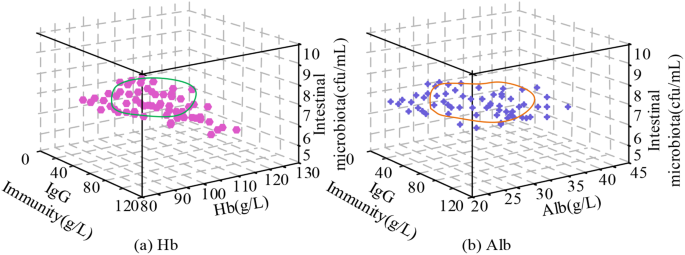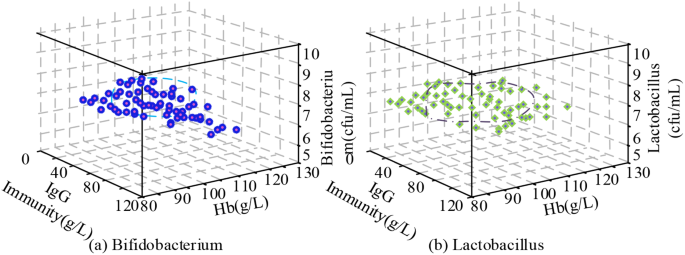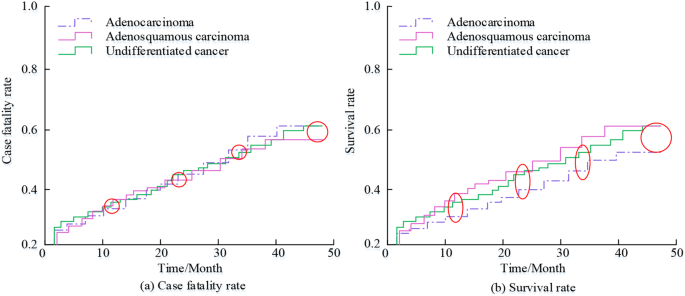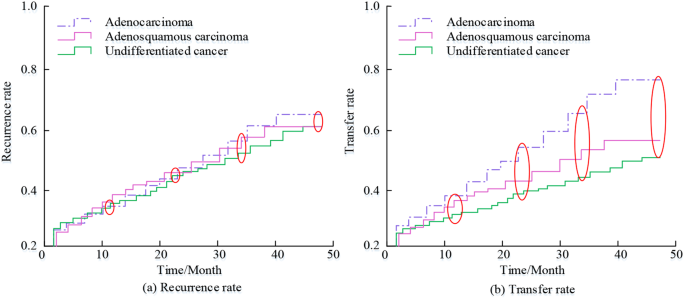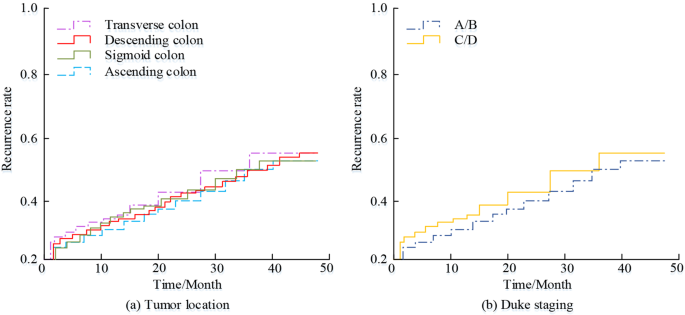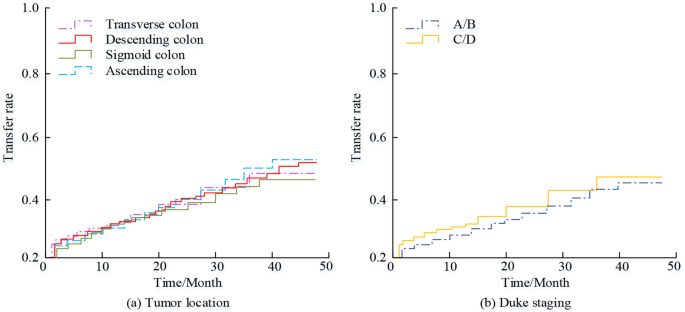Comparability of normal data
Desk 2 refers back to the primary data of the topics within the three teams. The info comparability of age, gender, tumour location, Duke stage and tumour diameter of the three teams had no statistical significance (P > 0.05). The info comparability of the following experiments was important.
Comparability of intestinal flora between totally different teams
Desk 3 refers back to the comparability of the intestinal flora earlier than and after surgical procedure in numerous teams. Bifidobacterium, Lactobacillus, Enterococcus faecalis, Escherichia coli, and yeast confirmed statistical variations earlier than and after surgical procedure among the many three teams of colon most cancers A-C, (P < 0.05). As well as, within the inter group comparability, there was no statistically important distinction within the Bifidobacterium, Lactobacillus, Enterococcus faecalis, Escherichia coli, and yeast among the many three teams of sufferers earlier than and after surgical procedure, (P > 0.05).
Comparability of the dietary standing amongst totally different teams
Desk 4 refers back to the dietary standing amongst totally different teams at totally different time factors. There was no statistically important distinction within the dietary standing of Hb, Alb, PA, TFN, and PNI amongst totally different teams earlier than surgical procedure, (P > 0.05). The 5 dietary indicators have been statistically important in all three teams at 1 week and 1 month postoperatively in comparison with preoperative, (P < 0.05). There was no statistically important distinction in dietary indicators amongst totally different teams earlier than surgical procedure, 1 week after surgical procedure, and 1 month after surgical procedure, (P > 0.05). As well as, the PA of Colon Most cancers Group A and Colon Most cancers Group C confirmed statistical variations at one week and one month after surgical procedure, (P < 0.05), whereas the Hb of Colon Most cancers Group A and Colon Most cancers Group B confirmed statistical variations at one month after surgical procedure, (P < 0.05). There was no statistically important distinction as compared between the opposite teams, (P > 0.05).
Comparability of immune operate amongst totally different teams
Desk 5 refers back to the immune features amongst totally different teams at totally different time factors. The six immune features of IgG, IgM, IgA, CD4+, CD8+, CD4+/CD8+ weren’t statistically important in numerous teams earlier than surgical procedure, (P > 0.05). In contrast with the preoperative interval, the six immune operate indicators within the three teams have been statistically important at 1 week and 1 month after surgical procedure, (P < 0.05). All of the CD8+ immune operate indicators decreased considerably, whereas the remaining 5 immune operate indicators elevated considerably. As well as, the IgG and IgM of Colon Most cancers Group A and Colon Most cancers Group B confirmed statistical variations at one week after surgical procedure, (P < 0.05). The IgG of Colon Most cancers Group A and Colon Most cancers Group B confirmed statistical variations at 1 month after surgical procedure, (P < 0.05). In the meantime, the CD8+ of Colon Most cancers Group A and Colon Most cancers Group C confirmed statistical variations at 1 month after surgical procedure, (P < 0.05). There was no statistically important distinction as compared between different teams, (P > 0.05).
Relationship between intestinal flora, dietary standing and immune operate
Bifidobacteria and Hb are used as indicators of intestinal flora and dietary standing, respectively, whereas IgG and CD4+ function indicators of immune operate. Determine 1(a) and Fig. 1(b) present the connection between intestinal flora, dietary standing and IgG and CD4+, respectively. The correlation between the three was important, starting from 0.758 to 0.852, (P < 0.05).
Bifidobacteria and IgG are used as indicators of intestinal flora and immune operate within the research, and Hb and Alb are chosen as indicators of dietary standing. Determine 2(a) and Fig. 2(b) consult with the connection between intestinal flora, immune operate and Hb and Alb respectively. The correlation between the three was important, starting from 0.746 to 0.849, (P < 0.05).
The research makes use of Hb and IgG as indicators of dietary standing and immune operate. Two indicators of intestinal flora have been chosen, Bifidobacterium and Lactobacillus. Determine 3(a) and Fig. 3(b) consult with the connection between dietary standing immune operate and Bifidobacterium and Lactobacillus, respectively. The correlation between the three was important, starting from 0.769 to 0.837, (P < 0.05).
Evaluation of the three survival curves
Determine 4(a) and Fig. 4(b) consult with the morbidity, mortality price and survival price of the three teams of overweight colon most cancers sufferers, respectively. The recurrence and metastasis price of sufferers within the three teams of adenocarcinoma, adenosquamous carcinoma and undifferentiated carcinoma had no statistical significance, (P > 0.05). At 4 years, for instance, the mortality price was 58.67%, 54.23% and 58.63% for adenocarcinoma, adenosquamous carcinoma and undifferentiated carcinoma, respectively. The survival price was 46.58%, 57.63% and 56.89%, respectively, which had no statistical significance, (P > 0.05). General, the mortality charges of overweight colon most cancers sufferers at 1, 2, 3 and 4 years have been 36.58%, 42.69%, 51.36% and 59.36% respectively, and the survival charges have been 31.26%, 39.58%, 44.23% and 48.69% respectively, all with statistically important variations, (P < 0.05).
Determine 5(a) and Fig. 5(b) consult with the recurrence and metastasis charges of the three teams of overweight colon most cancers sufferers, respectively. The recurrence and metastasis charges of sufferers within the three teams of adenocarcinoma, adenosquamous carcinoma and undifferentiated carcinoma weren’t statistically important, (P > 0.05). At 4 years, for instance, the recurrence charges of sufferers within the three teams of adenocarcinoma, adenosquamous carcinoma and undifferentiated carcinoma have been 64.35%, 58.36% and 57.36% respectively, and the metastasis charges have been 78.65%, 54.25% and 48.26% respectively. The variations have been additionally not statistically important, (P > 0.05). General, the recurrence charges of overweight colon most cancers sufferers at 1, 2, 3 and 4 years have been 32.25%, 41.26%, 48.95% and 60.25%, respectively, and the metastasis charges have been 35.26%, 39.64%, 48.36% and 65.26%, respectively, with statistically important variations, (P < 0.05).
Determine 6(a) and Fig. 6(b) consult with the recurrence charges for various tumour places and Duke stage, respectively. The recurrence charges of overweight colon most cancers sufferers with 1 12 months follow-up have been 32.06%, 33.26%, 31.26% and 32.63% for ascending, sigmoid, descending and transverse colon, respectively. The corresponding values for two years follow-up have been 42.25%, 40.26, 41.25% and 42.36%. The corresponding values for 3 years follow-up have been 48.25%, 50.23%, 43.26% and 53.69%. The corresponding values for 4 years follow-up have been 50.23%, 43.26%, 53.69%, and 51.36%. The recurrence charges for overweight colon most cancers sufferers with Duke stage A/B and C/D have been 38.56% and 31.26% respectively at 1 12 months follow-up, 42.36% and 38.56% respectively at 2 years follow-up, 45.36% and 34.36% respectively at 3 years follow-up. The corresponding values for 4 years have been 56.23% and 53.15%. The recurrence charges of overweight colon most cancers sufferers with totally different tumour places and Duke stage had no statistical significance, (P < 0.05).
Determine 7(a) and seven(b) consult with the metastasis charges for various tumour places and Duke stage, respectively. The metastasis charges for overweight colon most cancers sufferers with 1 12 months follow-up have been 27.56%, 28.31%, 26.53% and 28.16% for ascending, sigmoid, descending and transverse colon, respectively. The corresponding values for two years follow-up have been 36.26%, 35.46%, 36.78% and 38.26%, respectively. The corresponding values for 3 years follow-up have been 42.36%, 43.16%, 43.97% and 44.52%. The corresponding values have been 46.35%, 49.26%, 43.29% and 50.36% for the 4-year follow-up interval. The metastasis charges in overweight colon most cancers sufferers with Duke stage A/B and C/D have been 26.35% and 28.65% respectively at 1year follow-up, 37.26% and 34.56% respectively at 2 years follow-up, 42.36% and 39.86% respectively at 3 years follow-up and 46.35%. The corresponding values for 4 years have been 46.35% and 43.26%. The metastasis price in overweight colon most cancers sufferers with totally different tumour places and Duke stage was not statistically important, (P < 0.05).
The log-rank check outcomes of pairs of various tumor sorts (adenocarcinoma, adenosquamous carcinoma, and undifferentiated carcinoma) are proven in Desk 6. From Desk 6, there have been no statistically important variations in survival between adenocarcinoma and adenosquamous carcinoma, adenosquamous carcinoma and undifferentiated carcinoma, and adenosquamous carcinoma and undifferentiated carcinoma (P-value better than 0.05 after Holm correction). The outcomes counsel that after controlling for different doable confounding components, there was no important distinction within the influence of the three tumor sorts on affected person survival. This consequence could also be associated to a number of components, akin to remedy strategies, potential affected person situations, and so on.
The Cox regression outcomes of various variables are proven in Desk 7. From Desk 7, the HR of Duke stage (C/D vs. A/B) was 1.51, with a 95% confidence interval (1.26, 1.81) and a P-value lower than 0.001, indicating that sufferers with Duke stage C/D had a considerably greater danger of dying in contrast with sufferers with A/B stage. In distinction, tumor kind and tumor location had no important impact on survival time, and their HRs have been near 1, with P-value better than 0.05. This consequence additional illustrates the significance of Duke stage in predicting the prognosis of overweight colon most cancers sufferers, whereas tumor kind and placement might not be the primary components affecting survival time.


